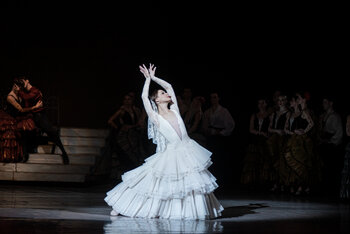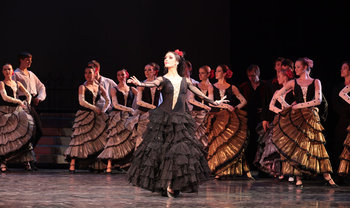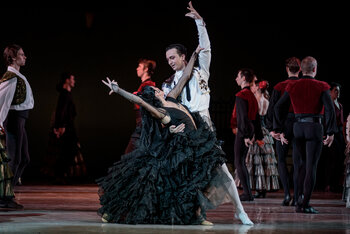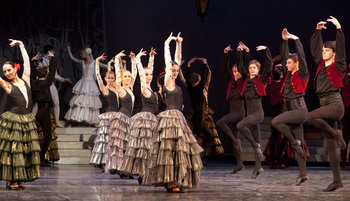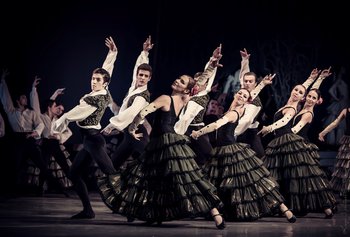Repertoire
20 minutes
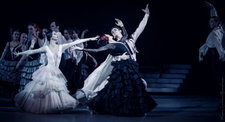
- Choreography and staging:
- Anatolii SHEKERA
- Artist:
- Danylo LIDER
- Costumes according to artist's sketches:
- Ariadna PEREPELITSA
- Conductors:
- Oleksii BAKLAN
- Allin VLASENKO
- Herman MAKARENKO
- Rehearsal tutor:
- Eleonora STEBLIAK
- Concertmasters:
- Svitlana TERENTIEVA
- Director who leads the performance:
- Alla VYSOTSKA
«БОЛЕРО» – НАЙПОПУЛЯРНІША СПАДЩИНА МОРІСА РАВЕЛЯ
Ініціатором створення твору виступила талановита російська танцівниця Іда Рубінштейн. Вона звернулася до композитора з проханням написати для неї балет. Моріс Равель закінчив партитуру досить швидко і вже 20 листопада 1928 року на сцені Паризької опери відбулася прем’єра «Болеро», яка згодом стала всесвітньо відомим твором.
Музика балету, танець Іди Рубінштейн, хореографія Броніслави Ніжинської та художнє оформлення Олександра Бенуа створили яскравий ансамбль, що захопив глядачів. Дія вистави відбувалася в іспанській таверні. На столі танцювала жінка. Її танець був центром, навколо якого нуртувало кохання й ревнощі. Але Равель уявляв собі цей балет дещо іншим. На сцені мав би розміститися корпус заводу, з якого виходили робітники та робітниці й танцювали на свіжому повітрі. На це композитора надихнули враження від давньої поїздки промисловими районами Бельгії та Рейну.
Незважаючи на те, що «Болеро» побудовано на іспанській тематиці, дослідники творчості Равеля відзначили, що темп і форма цього твору не мають нічого спільного з класичним болеро – парним тридольним танцем, якому властиві пожвавлений рух, енергійна зміна ритмічних фігур. До речі, темп равелівського «Болеро» вдвічі повільніший за темп класичного болеро. Очевидно, автор не мав наміру суворо дотримуватися традиційної трактовки популярного танцю і, як стало відомо, нерідко був байдужим до назв своїх творів, а іноді й не проти того, щоб дивувати своїх слухачів.
До цієї надзвичайної музики, сповненої протиріч між звабливою мелодикою у дусі іспанської пісенності та безпристрасним ритмом ледве чутного барабана, в різні часи зверталися такі відомі балетмейстери як Володимир Бурмейстер, Леонід Лавровський, Моріс Бежар…
Київська сцена збагатилася цим твором у 1968 році. І з того часу «Болеро» надовго увійшло до репертуару театру, приваблюючи глядачів своєю образністю та пластичністю.
Першою виконавицею партії головної героїні балету – Дівчини в білому – стала відома характерна танцівниця, заслужена артистка України Наталя Уманова.
Балетмейстер Анатолій Шекера, поставивши «Болеро» саме на Наталю Уманову, не помилився. Тогочасна преса відзначала, що у «Болеро» артистка виступила не просто танцівницею, а й актрисою, яка досягла великої драматичної виразності.
Світлана Горяная

